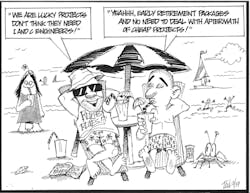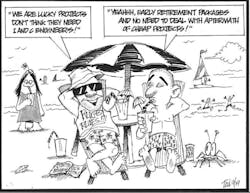Instrument specification: Where we are and where we should be
This Control Talk column appeared in the October 2019 print edition of Control. To read more Control Talk columns click here or read the Control Talk blog here.
Greg: Instruments provide the view into the process and means of controlling it. If they’re not telling the truth, we are in serious trouble. If you can’t measure it, you can’t control it. Not as well recognized is the fact that if you cannot precisely set a flow, you can’t do what the measurement and control system says is needed. It all starts with the specification.
Mike Laspisa offers his insights as to where we are now and where we should be with instrumentation specification based on 37-plus years working in the instrumentation and control (I&C) discipline, including 32 years as a lead I&C engineer or manufacturing plant staff I&C engineer. I spent most the of the 1970s in instrument and electrical (I&E) design and construction, and to this day, the performance of instrumentation is foremost in my mind (as seen in my Control Talk columns, “A meeting of the minds” and “Meeting of minds encore”). Mike’s goals are very similar to mine in terms of wanting to share our knowledge often learned the hard way to help automation engineers do what is best.
Mike, what were the original intents and methods for I&C specification from the late 1970s to the late 1980s?
Mike: Field device importance was held in high regard. Measurement and control device specification was a science and could only be learned on the job. I&C engineers were considered an important asset by both the company and the client. Instrument engineers specified measurement devices, and selected and sized control valves, regulators and safety relief devices using process data, process and instrument diagrams (P&IDs), and pipe specs. A control valve outside sales engineer would review the engineer’s selection and discuss difficult applications. Valve sizing calculations were always done by the engineer doing the valve specification.
Device selection took into account both application requirements and device cost. However, performance was the primary selection criteria. Process data was analyzed by the I&C engineer for each measurement and control application, including control valve sizing pressure drop, flow measurement turndown, and multiple case studies, if applicable. Accuracy, advanced control strategies, ratio blending, batch addition resolution, and many other requirements were discussed with process engineers during joint P&ID development.
However, mass flow measurement choices were limited (e.g., load cells, weigh belt, and volumetric flow with pressure and temperature compensation by remote electronics or computational module).
Greg: How would you describe our current situation?
Mike: Project bottom line focus has led to cost-effectiveness becoming almost more important than performance in instrumentation and control device selection. In addition, I&C device vendors are being asked to select/size field devices more often based solely on the data provided on a datasheet. A reduced budget for I&C specification work is now expected for projects and by some clients. Unfortunately, I&C device vendors are using a younger inside sales force that seem to be relying mostly on software for quotations without the experience to ask the right questions or quote needed accessories.
Fast-track engineering has almost become the standard. This sometimes leads to preparing I&C device specifications without the necessary information to specify them completely. Also, process data is usually provided late and is furnished incomplete or in partial installments. I&C engineer value, or project early involvement, is questioned by project management. Process, or sometimes even project, engineers think they can make the early decisions on required I&C devices, or assist the client in P&ID development.
Relying on vendors to select and/or size I&C devices has negatively impacted the development of I&C specifying engineers. This has this led to I&C engineers not questioning process data and issuing incomplete datasheets. Reduced budgets and fast-track engineering have also compromised the datasheet checking process. The focus now appears to be more on checking tags against P&IDs rather than application information (sizing, materials of construction, end connections/rating, pipe spec., etc.) and the completeness of the critical process data required to support the sizing and selection of the device.
On the other hand, there are some bright technology developments that have made I&C device applications easier (and more forgiving), such as mass flowmeters, smart transmitters with wide rangeability, multivariable transmitters, radar level transmitters and digital valve positioners.
Greg: I&C engineers should ask process engineers what accuracy is required. In my experience, the accuracy they want is aggressive and was often not achievable until recently. The advent of temperature compensation and digital devices combined with many smart features has reduced drift and offsets by more than an order of magnitude, increasing calibration intervals from a few years to a decade. I remember how difficult and temporary was the calibration of pneumatic positioners, leading to low and high output limits of -10% and 110%, respectively, to make sure the valve was completely closed and open. The most common continuing issue with sensors are with thermocouples and pH electrodes, which may require calibration intervals less than a year to maintain the accuracy expected by the process engineer. We still have problems with impulse lines, equalization lines and capillary systems causing significant errors, as discussed in the Control Talk columns, “Prevent pressure transmitter problems” and “Your DP problems could be the result of improper use of purges, fills, capillaries, and seals.”
Advances in control valve performance include recognizing that positioners need to be tuned with high gain; higher-pressure diaphragm actuators can handle larger valves and higher pressure drops with greater sensitivity and resolution than piston actuators; splined shaft connections for rotary valves greatly reduce backlash; v-notch ball and contoured-disk butterfly valves offer better throttling and flow characteristics; and what I hope is the recognition and avoidance of on-off valves posing as throttling valves, as noted in the Control article, “Is your control valve an imposter?” Valve specifications, unfortunately, emphasize leakage and capacity with no entry for resolution and response time. The result is a piping spec rotary valve used for isolation and on-off control with a piston actuator, and often a cheap spool positioner. Putting a smart digital valve controller on such a poser does little good because it is being lied to by actuator shaft feedback saying the valve is responding despite the ball or disk not moving. For a much brighter future in the specification of control valves, see points 4 and 5 in the Control Talk blog, “Missed Opportunities in Process Control - Part 6,” and ISA Mentor Q&A post, “Basic Guidelines for Control Valve Selection and Sizing.”
Mike, how does this history or commentary relate to instrument specification work at engineering, procurement and construction (EPC) firms?
Mike: When I was reviewing project work before I retired, I observed a number of specification deficiencies that included incomplete or incorrect datasheets. Calibrated ranges didn’t always take into account the minimum, normal and maximum process requirements and sensor rangeability. I have seen datasheets where the vendor was to select the device size, model, trim, etc. from limited, or possibly unintentionally skewed, information (e.g., all globe valves with 5 psi valve drop for sizing, regulators using pilots where they weren’t required, etc.). Some specific application requirements (e.g., magmeters missing ground straps/rings/ground electrodes, flow primary element selection not compatible with process pipe/duct, analytical probe connection requirements not considered during specification, level measurement selection not compatible, or practical, for application) were not specified correctly. Is this a checking issue, a philosophy issue (i.e., leave it up to the vendor whenever possible), or a misunderstanding of what is required?
The interface with piping designers, including in-line installation detail preparation, is more after-the-fact than timely to the piping design effort. Packaged system instrumentation is a shared responsibility, but process design usually is in the lead. Historically, I&C does not get involved with the measurement requirements, only the hardware preferences, control system choices and device signal levels.
Greg: We have to be especially careful to make sure packaged equipment suppliers use the latest and best technology consistent with plant standards. Often, to win a packaged equipment low bid, I have seen pressure and temperature gauges used instead of smart digital transmitters, and really crummy cheap valves used instead of true throttling valves with digital valve controllers. Also, special field controllers with strange algorithms are mistakenly used that reduce visibility, operability, tuning and performance. Some field temperature controller suppliers promote fuzzy logic as the answer, not realizing that PID structures and adaptive tuning offer better and more maintainable solutions.
Mike: The package instrumentation, control devices and control system (including the interface with the plant control system) must meet the equipment specification expectations/requirements (e.g., manufacturer or equal, type or series, and control system preference). There have been many examples where the plant standards, or even preferred vendors, were ignored to save money by accepting OEM devices, well after the specification phase.
Greg: Mike, what is needed for a much better future in the specification of I&C devices?
Mike: Better use of appropriate instrumentation and control device learning opportunities (courses, exhibitions, free vendor/manufacturer seminars, lunch-and-learns, asking a lot of intelligent questions and mentoring). Provide internal or external technical resources to discuss device-type applications during datasheet preparation. Develop the preferred role of vendors and I&C engineers in selection and sizing of I&C devices. Discuss the expectations for instrument process data analysis. Determine the critical data fields, or notes, for the different I&C devices. Datasheet checking must cover technical content as well as device checks against P&IDs for tag and service. See the “Instrument Datasheet Preparation Flowchart” for the recommended approach to specifying instrumentation and control devices. Develop a standard naming convention for instrument package workbooks, worksheets and archiving. Discuss vessel connection responsibilities, requirements and impact on device specification. EPC firms need to get I&C engineers more involved in the packaged equipment system specification process and bid review. Process engineers commonly use vendors to create their package specifications, but they rarely have an I&C engineer involved in any conversations or meetings.
Greg: Throughout my career, I sought out the best expertise wherever it existed. I was fortunate that I could talk with many in-house, experienced I&C engineers, talented specialists and the key people responsible for the technology at the manufacturers of instrumentation and valves. My questions were intelligent enough that people seemed to enjoy the conversation as much as I did. Doing the Control Talk column for the past 16 years has been a great privilege. From a series of brief conversations and focused questions by email, I often get the heart of what very talented and hardworking practitioners have learned and achieved. Plus, I get to share it with a wide audience to help advance the profession by practical knowledge learned from applications in the process industry.
10. Always specify line-size control valves.
9. Always specify line-size vortex meters.
8. Choose control valves with the tightest shutoff and greatest capacity.
7. Simply make maximum flows 10x the normal flows on specifications.
6. Blanks on the specification sheets spur vendor creativity.
5. No problem with the process flow diagrams (PFDs) being 20 years old.
4. The temperature, pressure, concentration and density are always at the values on the PFD.
3. The Industrial Internet of Things will solve any I&C problems we might have by reducing the project budget.
2. Go with the lowest bid on everything.
1. We don't need to spend the money or time to get I&C engineering involved before project approval.
About the Author
Greg McMillan
Columnist
Greg K. McMillan captures the wisdom of talented leaders in process control and adds his perspective based on more than 50 years of experience, cartoons by Ted Williams and Top 10 lists.

Leaders relevant to this article:



